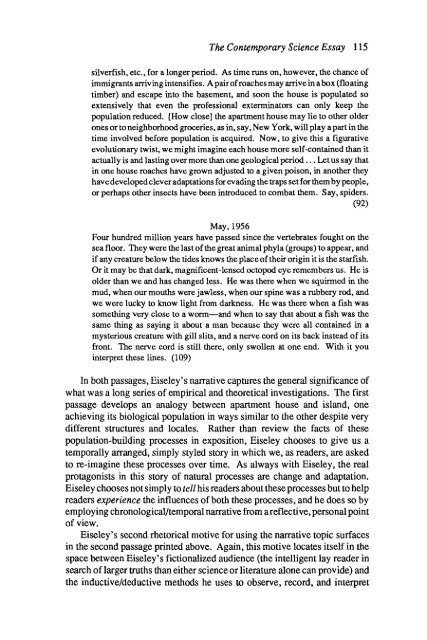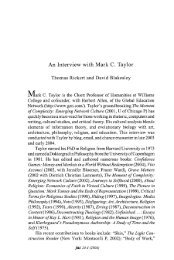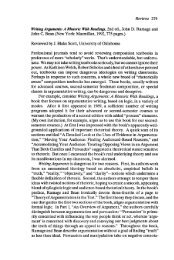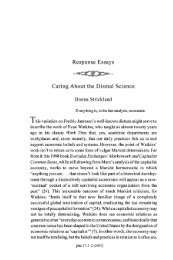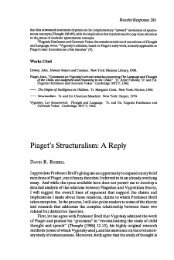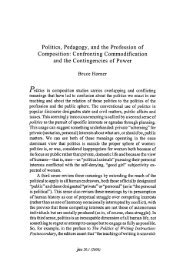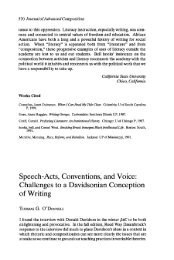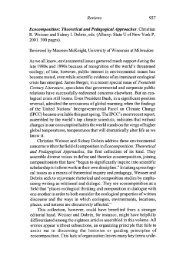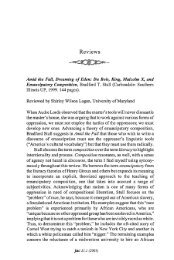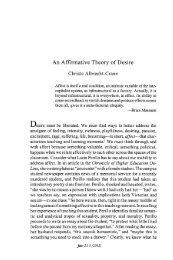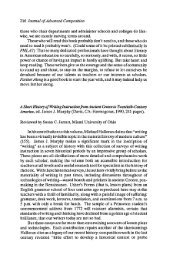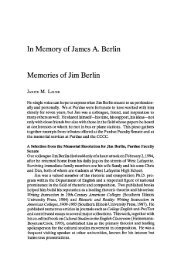Narrative Topic and the Contemporary Science Essay ... - JAC Online
Narrative Topic and the Contemporary Science Essay ... - JAC Online
Narrative Topic and the Contemporary Science Essay ... - JAC Online
You also want an ePaper? Increase the reach of your titles
YUMPU automatically turns print PDFs into web optimized ePapers that Google loves.
The <strong>Contemporary</strong> <strong>Science</strong> <strong>Essay</strong> 115<br />
silverfish, etc., for a longer period. As time runs on, however, <strong>the</strong> chance of<br />
immigrants arriving intensifies. A pair of roaches may arrive in a box (floating<br />
timber) <strong>and</strong> escape into <strong>the</strong> basement, <strong>and</strong> soon <strong>the</strong> house is populated so<br />
extensively that even <strong>the</strong> professional exterminators can only keep <strong>the</strong><br />
population reduced. [How close] <strong>the</strong> apartment house may lie to o<strong>the</strong>r older<br />
ones or to neighborhood groceries, as in, say, New York, will playa part in <strong>the</strong><br />
time involved before population is acquired. Now, to give this a figurative<br />
evolutionary twist, we might imagine each house more self-contained than it<br />
actually is <strong>and</strong> lasting over more than one geological period ... Let us say that<br />
in one house roaches have grown adjusted to a given poison, in ano<strong>the</strong>r <strong>the</strong>y<br />
have developed clever adaptations for evading <strong>the</strong> traps set for <strong>the</strong>m by people,<br />
or perhaps o<strong>the</strong>r insects have been introduced to combat <strong>the</strong>m. Say, spiders.<br />
(92)<br />
May, 1956<br />
Four hundred million years have passed since <strong>the</strong> vertebrates fought on <strong>the</strong><br />
sea floor. They were <strong>the</strong> last of <strong>the</strong> great animal phyla (groups) to appear, <strong>and</strong><br />
if any creature below <strong>the</strong> tides knows <strong>the</strong> place of <strong>the</strong>ir origin it is <strong>the</strong> starfish.<br />
Or it may be that dark, magnificent-lensed octopod eye remembers us. He is<br />
older than we <strong>and</strong> has changed less. He was <strong>the</strong>re when we squirmed in <strong>the</strong><br />
mud, when our mouths were jawless, when our spine was a rubbery rod, <strong>and</strong><br />
we were lucky to know light from darkness. He was <strong>the</strong>re when a fish was<br />
something very close to a worm-<strong>and</strong> when to say that about a fish was <strong>the</strong><br />
same thing as saying it about a man because <strong>the</strong>y were all contained in a<br />
mysterious creature with gill slits, <strong>and</strong> a nerve cord on its back instead of its<br />
front. The nerve cord is still <strong>the</strong>re, only swollen at one end. With it you<br />
interpret <strong>the</strong>se lines. (109)<br />
In both passages, Eiseley's narrative captures <strong>the</strong> general significance of<br />
what was a long series of empirical <strong>and</strong> <strong>the</strong>oretical investigations. The first<br />
passage develops an analogy between apartment house <strong>and</strong> isl<strong>and</strong>, one<br />
achieving its biological population in ways similar to <strong>the</strong> o<strong>the</strong>r despite very<br />
different structures <strong>and</strong> locales. Ra<strong>the</strong>r than review <strong>the</strong> facts of <strong>the</strong>se<br />
population-building processes in exposition, Eiseley chooses to give us a<br />
temporally arranged, simply styled story in which we, as readers, are asked<br />
to re-imagine <strong>the</strong>se processes over time. As always with Eiseley, <strong>the</strong> real<br />
protagonists in this story of natural processes are change <strong>and</strong> adaptation.<br />
Eiseley chooses not simply to tell his readers about<strong>the</strong>se processes but to help<br />
readers experience <strong>the</strong> influences of both <strong>the</strong>se processes, <strong>and</strong> he does so by<br />
employing chronological/temporal narrative from areflective, personal point<br />
of view.<br />
Eiseley's second rhetorical motive for using <strong>the</strong> narrative topic surfaces<br />
in <strong>the</strong> second passage printed above. Again, this motive locates itself in <strong>the</strong><br />
space between Eiseley's fictionalized audience (<strong>the</strong> intelligent lay reader in<br />
search of larger truths than ei<strong>the</strong>r science or literature alone can provide) <strong>and</strong><br />
<strong>the</strong> inductive/deductive methods he uses to observe, record, <strong>and</strong> interpret


